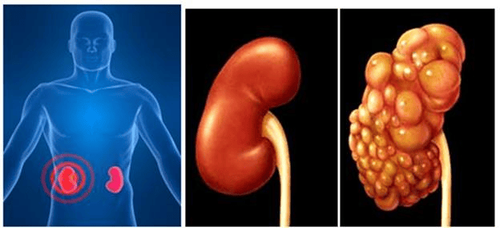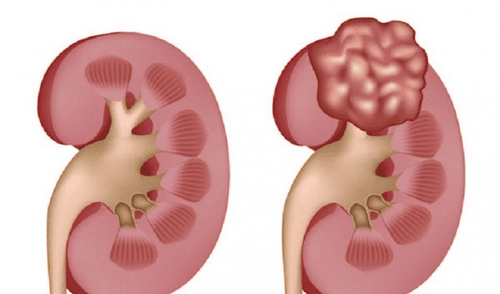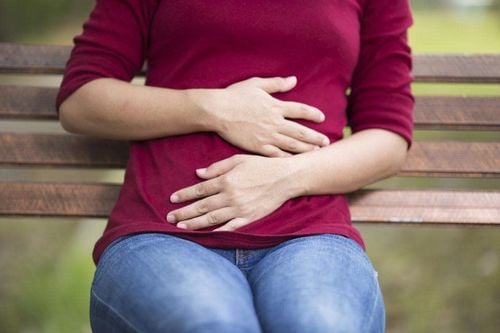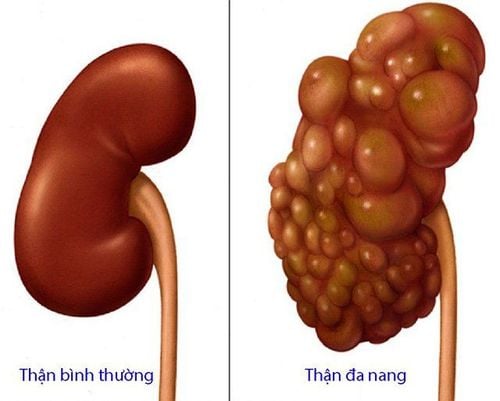This is an automatically translated article.
The article is professionally consulted by - Head of Department of Medical Examination & Internal Medicine - Vinmec Ha Long International General Hospital.
Renal cysts and polycystic kidneys are both common kidney diseases. Cysts of polycystic kidney disease are different from renal cysts and other normal cysts that form in the kidney later in life. Compared with cystic kidney disease, the etiology of polycystic kidney disease is more clearly defined as oncogenesis.
1. Kidney cyst
During the process of reabsorption and excretion of the kidneys, urine from the renal pelvis will go down the ureter to the bladder and then out through the urethra. For some reason, any kidney unit is blocked, urine is trapped to form a water-filled sac called a renal cyst.
Renal cyst is a closed sac containing fluid inside, usually round or oval in shape, growing in the renal cortex. The fluid contained in the renal cyst is usually a clear, yellowish-yellow fluid.
Renal cysts can be single or multiple cysts with different sizes from 1-10cm, with walls up to several millimeters thick, made up of 3 layers of fibrous tissue:
Inner layer: columnar epithelium. Middle layer: smooth muscle fibers. Outer layer: cystic shell is structured like atrophic renal tubules. Renal cyst is a benign disease.
There is a study that up to 30% of people over 70 years old have at least one kidney cyst. Renal cystic disease tends to increase with age, the size of the cyst also increases gradually over time.

Ở độ tuổi ngoài 50 tuổi, nguy cơ mắc bệnh nang thận là 50%
1.1 The cause of kidney cysts is still not clear, so the medical profession thinks that this is an acquired disease. Some risk factors can lead to kidney cysts due to acquired such as:
Age problems: over 50 years of age, the risk of kidney cysts is 50%. Inflammatory diseases of the urinary tract causing obstruction of the renal tubules. Suffering from diseases related to kidney structure and function such as calyces diverticulum, weak basement membrane of renal tubules, proximal tubule occlusion or congenital renal cyst due to defects in the embryological development of the kidney... 1.2 Manifestations of renal cysts When kidney cysts are small, there are usually no clinical manifestations, nor do they affect the urinary system as well as the excretion of the kidneys. When the size of the cyst grows, it causes pressure around it, which can lead to urinary disorders such as painful urination with hematuria. Cysts press on renal calyx causing back pain, hip pain, even rupture of kidney cyst, infection causing fever... 1.3 Complications of kidney cyst Infection in kidney cyst. Renal cyst rupture. Enlarged renal cysts compress surrounding and renal structures. Renal cysts rarely cause complications or cause kidney disease. It only affects the kidneys and other organs when it is larger than 6cm. Kidney cysts do not go away on their own and currently there is no specific medicine or medicine. Anemia, increased blood pressure.
2. Differentiate between polycystic kidney and cystic kidney

Khác với nang thận, thận đa nang là một bệnh lý thường gặp trong các bệnh lý về nang thận, là nguyên nhân hay gặp gây nên suy thận, ung thư thận
Different from kidney cysts, polycystic kidney is a common disease in kidney cyst diseases, a common cause of kidney failure, kidney cancer. Like kidney cysts, up to now, there is no specific treatment for polycystic kidney disease.
Compared with cystic kidney disease, the cause of polycystic kidney is more clearly defined as the development and development of renal cysts related to genetic or environmental factors or both, chemical substances or a number of other medications. To account for the formation of polycystic kidney disease, three pathological mechanisms have been proposed:
Obstruction in the lumen of the renal tubule : Animal experiments, using oxidants to induce polycystic kidney disease follicle. The results showed that the cells in the collecting duct wall in the renal medulla proliferate to form polyps located along the collecting duct. It is these polyps that cause a blockage in the renal tubules, leading to water retention and the formation of pockets called renal cysts. In the wall of the renal tubule, no micropolyp was found. Renal tubular epithelial cell proliferation: this may be associated with epithelial cell dysplasia. When the number of epithelial cells increases sharply in the dilated renal tubules, cysts are formed. Changes in the tubular basement membrane: In animals with polycystic kidney disease, altered tubular basement membrane components have been found, such as decreased proteoglycan synthesis in mice... When the basal membrane is altered, the tubules are altered. dilated kidneys form cysts. This condition may be related to genetic factors (dominantly inherited polycystic kidney disease). Like cystic kidney disease when small in size, the early stage of polycystic kidney often has no obvious clinical manifestations. The disease is usually detected in middle age or older, or detected early through abdominal ultrasound or routine examination.
Polycystic kidney disease causes:
Increase in the size of the kidneys, which can increase weight up to 7-8kg. Abdominal pain or pain in the lumbar region (about 20-30% of patients have this symptom). Symptoms increase as kidney size also increases. Acute pain may be oriented towards fragility, acute bleeding within the cyst, or severe obstruction of the cyst, either by a stone or by a blood clot. In some cases, pain in the right lower quadrant may be experienced due to the presence of liver cysts. Bleeding in the cyst causes hematuria. Approximately 15-20% of patients have gross hematuria. The incidence of gross hematuria as well as its frequency increases with the degree of renal growth and also depends on the longitudinal diameter of the kidney. If the longitudinal diameter of the kidney is less than 15cm, the gross hematuria rate is about 14%, but if the longitudinal diameter of the kidney is more than 15cm, this rate can be up to 43%. In polycystic kidney disease, when many cysts appear that can enlarge the kidney, the functional units of the kidney are almost replaced by cysts leading to kidney failure or chronic kidney disease.
Complications of polycystic kidney disease:
Urinary tract infections are often the reason why patients are hospitalized. Infection rates are higher in women than in men. Kidney stones account for 11-34%, this rate is equal in men and women. Renal failure is the most common complication of polycystic kidney disease. Renal cancer that is mainly renal cell cancer, a few cases with renal papillary cancer. Approximately 50% of cancer cases occur in patients with autosomal dominant polycystic kidney disease. Affect other organs such as liver cysts (inherited dominant), intracranial aneurysms, heart valve abnormalities... In polycystic kidney disease, the number of cysts is very large, and when they growing in size causes a lot of complications that greatly affect health, even life-threatening. The mechanistic etiology of polycystic stem is also more clearly defined than that of renal cysts. However, to date, there is no specific treatment or cure for these two diseases.
Please dial HOTLINE for more information or register for an appointment HERE. Download MyVinmec app to make appointments faster and to manage your bookings easily.













